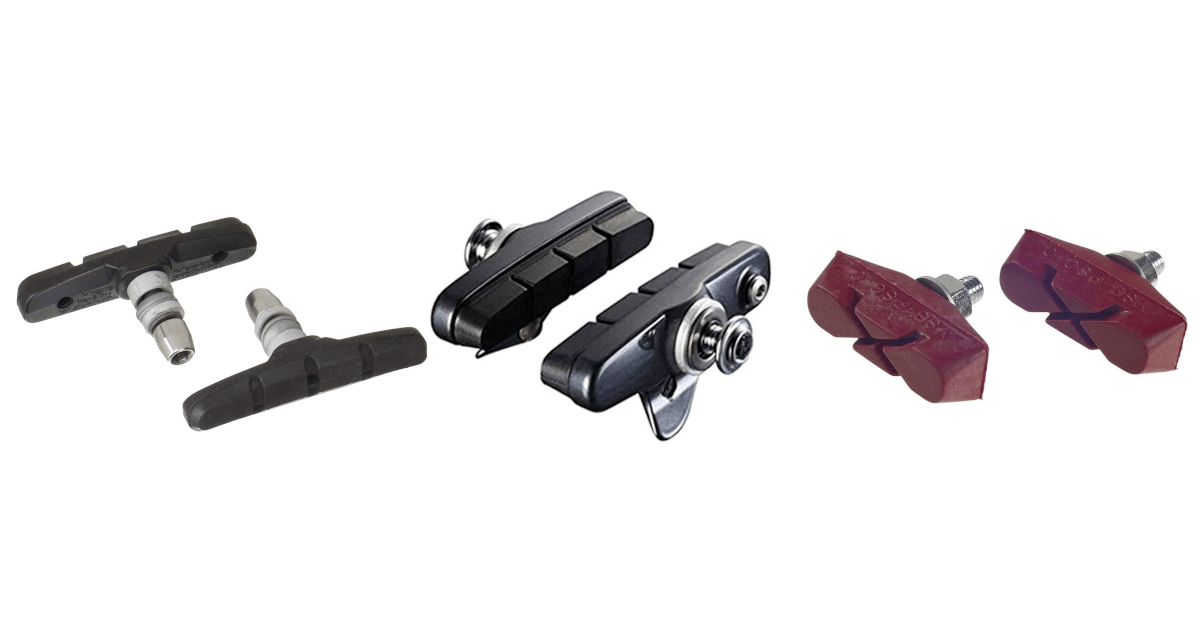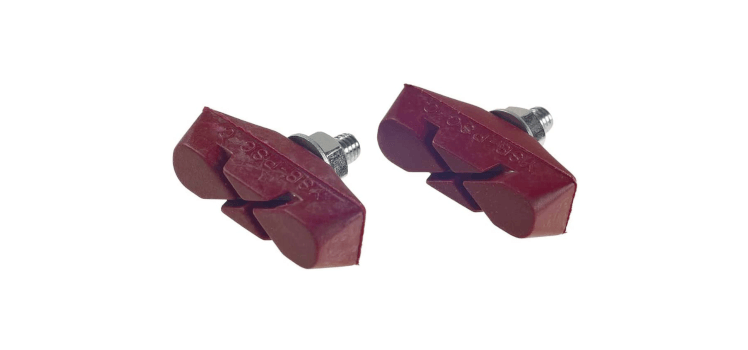What Is Shimano Shadow RD? Features and Benefits
What is Shimano’s Shadow RD used in their latest rear derailleurs? This article explains its features and the benefits of choosing Shadow RD.
Posted at: Nov 2, 2021
Of all the bicycle parts, brake shoes are the most frequently replaced along with tires and tubes. The following is a summary of the types of brake shoes and notes on compatibility, which are said to work better if they are used at the top level.

Table of contents
Sponsored Link
There are different types of bicycle brake shoes.
Road bikes and city bikes have caliper brakes with small brake shoes. They are similar in size, but differ in width and thickness.

On the other hand, V-brakes and cantilever brakes, which are common on hybrid bikes and MTBs, are often equipped with larger brake shoes for more stopping power.
The most common type of brake shoe is the one that has the connection fitting and shoe in one piece, but the most common type of brake shoe in the higher-end brakes for road bikes is the cartridge type.
Cartridge-type brake shoes have separate brake shoe fittings, which are the foundation, and shoes made of rubber material, so that only the rubber part can be replaced, resulting in lower replacement costs.
Basically, the rim of a rim brake bicycle is made of metal such as aluminum, but in the case of high quality wheels such as carbon wheels, the rim may be made of carbon material.
In the case of carbon rim wheels, the brake shoes must be specially designed for carbon rims.
The best brake shoes for the brakes on your bicycle are the genuine parts of the manufacturer. If you can get the genuine parts from the manufacturer, it is best to choose the genuine parts.
However, in the case of no-name brakes installed on budget bicycles, the manufacturer’s genuine parts are often not available, so in that case, you will have to look for brake shoes of the same size.
If you choose the same type of brake shoes from Shimano, one of the top bicycle parts manufacturers, you are unlikely to be disappointed.
On the other hand, you can basically use the same brake shoes as long as the “shoe connection screw” and “shoe thickness” are the same. Some people use Ultegra brake shoes for road bikes on their mom bikes.
However, be aware that V-brake and cantilever brake shoes are wide and may interfere with the front fork and seat stay if installed on a bike with severe tire clearance such as a road bike.
For cartridge-type brake shoes, the size of the base of the shoe is very critical, so be sure to check the manufacturer’s compatibility information before replacing them.
The combination of an incorrectly sized base and shoe may reduce braking performance.
We have looked at the compatibility of brake shoes.
Unlike brakes and shifters, the relatively primitive structure of brake shoes makes it possible to install any type of brake shoe, but if you don’t check the size and other factors for compatibility, you may lose braking power or damage brake parts, so be sure to choose carefully.
Sponsored Link
Types and Differences of Brakes for Sports Bicycles
Sports bicycles are equipped with various types of brakes. Here is a summary of each brake, its features and differences, advantages and disadvantages, and which brake bike you should buy in the future.
How to lighten heavy mechanical brakes.
The weight of the brakes not only affects the braking power, but also creates a significant impact on fatigue during the ride. In this article, we'll take a look at how mechanical brakes work and how you can lighten the weight of heavy brakes.
Selecting Shimano Brakes for Road Bikes: A Summary of Model Numbers
Brakes are an important part of a road bike that is responsible for braking. In this article, we will discuss how to select Shimano brakes for road bikes, which are of high quality and highly available in Japan, and summarize the model numbers of each grade of brake.
The higher the grade, the better it works! Brake shoe types and interchangeability
Of all the bicycle parts, brake shoes are the most frequently replaced along with tires and tubes. The following is a summary of the types of brake shoes and notes on compatibility, which are said to work better if they are used at the top level.
Shimano's older high-grade brakes vs. current lower-grade brakes: Which is better?
Which is better, Shimano's older generation higher grade brakes or the current lower grade brakes? This article examines Shimano's brake technology and the year they were released.
Road Bike to Disc Brakes Conversion: Parts Needed and Buying Tips
Disc brake-equipped road bikes have been on the rise in the past few years. "For those who want to try out disc brakes but don't want to buy a new bike, we've put together a list of the parts you'll need to buy disc brakes and the points to keep in mind when buying.
Differences and Identification of Disc Brake Only Wheels
Disc brake bicycles require wheels specially designed for disc brakes. In this article, we will discuss what is the difference between disc brake-specific wheels and rim brake-specific wheels. What is the difference between a disc brake wheel and a rim brake wheel? Or rim brake only? When selecting a wheel, it is important to know how to tell the difference.
Should I use disc brakes or rim brakes?
Disc brakes are coming of age, and conventional rim brakes such as caliper brakes and V-brakes. This article summarizes the differences between them and which is better.
What Is Shimano Shadow RD? Features and Benefits
What is Shimano’s Shadow RD used in their latest rear derailleurs? This article explains its features and the benefits of choosing Shadow RD.
Shimano Chain Compatibility for Road, MTB, and Hybrid Bikes
An overview of Shimano chain compatibility across road bikes, mountain bikes, and hybrid bikes. Includes guidance on how to choose the right chain for your drivetrain.
Shimano ESSA Lineup and Compatibility with Existing 8-Speed Parts
An overview of Shimano's newly released 8-speed component group "ESSA" and its compatibility with existing 8-speed parts.
SRAM Cassette Compatibility Guide
Compatibility guide for SRAM cassettes used in road and MTB bikes. Find matching drivetrains and wheels easily.
Compatibility Guide for SRAM MTB Components
A detailed explanation of compatibility between SRAM MTB components. This guide outlines which parts can be used together and which combinations are not compatible.
Road and MTB Sprockets Compatibility Overview
A guide to the compatibility between road and MTB sprockets, explaining whether they can be used together with different components.
Shimano CUES Cassette Compatibility Guide
A detailed guide to the compatibility of Shimano CUES series cassettes. Includes an overview of compatible rear derailleurs, chains, and wheels.
Shimano Hydraulic Brake Hose and Connector Standards Guide
An explanation of the differences between Shimano’s hydraulic brake hoses BH90 and BH59, the types of connecting bolts, and how to choose the right hose for your brake system—including key points to watch out for.
Types and Compatibility of Shimano Di2 Batteries
The Di2 battery is the core of the Shimano Di2 system, influencing the overall system layout. This article explains the different types and their compatibility.
Shimano Di2 Wire Types and Compatibility
Overview of Shimano Di2 electric wire types and their compatibility with Di2 components.
How to Identify Shimano Di2 Generations
Explains the generational differences in Shimano Di2 components and their compatibility. Includes a list of component series and their corresponding generations.
In-Depth Guide to Shimano 12-Speed Cassette Compatibility
A detailed explanation of the key compatibility factors when using Shimano's 12-speed cassettes—specifically the required wheel (freehub) and drivetrain, which differ significantly from previous 11-speed systems.
Perfect Guide to Shimano 11-Speed Cassette Compatibility
A detailed explanation of two key compatibility factors when using Shimano 11-speed cassettes: the required wheel (freehub) and drivetrain.
Perfect Guide to Shimano 10-Speed Cassette Compatibility
A detailed explanation of two key compatibility factors when using Shimano 10-speed cassettes: the required wheel (freehub) and drivetrain.
In-Depth Guide to Shimano 9-Speed Cassette Compatibility
A comprehensive explanation of two key compatibility factors when using Shimano 9-speed cassettes: the required wheel (freehub) and drivetrain.
Shimano I-SPEC Shift Lever Mount Standards Explained
A complete guide to Shimano's I-SPEC shift lever mount standards, covering features, differences between models, and compatibility.
Shimano Hydraulic Disc Brake Standards and Selection Guide
Unlike mechanical brakes that only pull a cable, hydraulic disc brakes come with various standards and technologies depending on the manufacturer. This article highlights Shimano’s hydraulic disc brake technologies and standards, along with key points to consider when selecting one.
Shimano CUES Components Lineup and Compatibility Guide
A comprehensive guide to Shimano's new CUES component group for MTB and lifestyle categories, including gear ratios, part lineup, and compatibility with traditional components.
TPU Inner Tube: Features, Pros, and Cons for Road Bikes and MTB
TPU inner tubes are gaining attention as the third force in bicycle tires. We summarize its features, advantages and disadvantages of using it on Road bikes and MTBs, and major manufacturers.
Shimano Mechanical Brake Levers for MTB and Hybrid Bike
Shimano mechanical brake levers are now few and far between. The following is a summary of the current model lineup, specifications, and compatible components.